IYA2009 Updates
International Epsilon Aurigae Campaign 2009 - 2011
8 February 2010
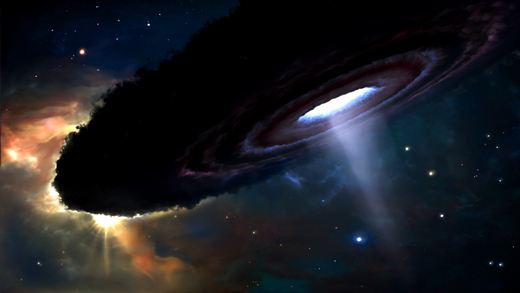
Every 27.1 years the very mysterious variable star epsilon Aurigae undergoes an eclipse that lasts nearly 2 years. This is an easily found 3rd magnitude star visible from the northern hemisphere. It is one of a trio of stars that form a small triangle called "The Kids" just southwest of Capella. While there is no shortage of theories, the precise nature of the star system remains a mystery. During the last eclipse 1982.1984 a Campaign was formed to observe and try to figure out answers. Great deal of information was obtained, yet there are still many unanswered questions. Beginning in the summer of last year (2009) the latest eclipse started. In 2006 an International Campaign was again formed and an official web site devoted to the current eclipse created. See http://www.hposoft.com/Campaign09.html
We have amateur and professional observers from around the world (18 countries) providing photometric and spectroscopic data of the star system. Some observers are also providing interferometry and polarimetry data. We have published 16 Newsletters so far for this Campaign. We encourage anyone interested in this star system to join the Campaign.
TWAN Newsletter
8 February 2010
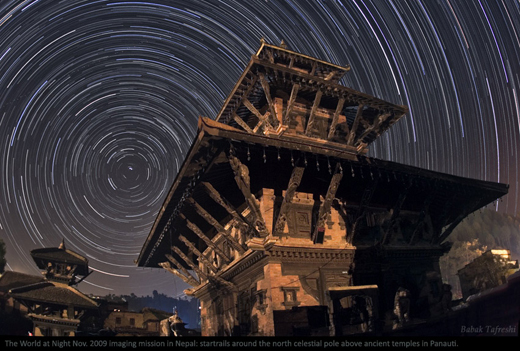
News and Report
- Photo Report: TWAN in the Land of Himalaya - The first TWAN mission to Nepal created amazing starry photos of the top of the World and resulted in an imaging workshop and promising collaborations with the country’s growing astronomy community.
- Photo Report: The World at Night Across Chile - Chile was one of the most successful countries in hosting TWAN events during the IYA2009 with exhibitions in 30 locations across the country including the presidential palace in Santiago.
- Find new exhibitions and workshops around the world in TWAN Events Table.
- Shop framed prints, postcards, and other favorite TWAN promotional items in Cafe Press.
There are new stunning photos and time-lapse videos on TWAN website, featuring starry nights of the planet's landmarks from across the world.
Americas
USA
- Mars and a Colorful Lunar Fog Bow by Wally Pacholka
- Galactic View by Wally Pacholka
- Starry Sky above Silversword by Wally Pacholka
- Moon and Jupiter over the Crater Rim by Wally Pacholka
- Crescent Descent by Doug Zubenel
- PlanetCatcher and Mars by Doug Zubenel
- Heavenly Halo by Doug Zubenel
Canada
- Newfoundland Milky Way by Yuichi Takasaka
- The Northern Lights by Kwon O Chul
- Aurora in Motion (time-lapse video) by Kwon O Chul
Chile
- Starry Motion above Easter Island (time-lapse video) by Stephane Guisard
- Gemini in Motion from Inside and Outside (time-lapse video) by Stephane Guisard
Europe
France
- Night in the Carnac Stones (VR) by Laurent Laveder
- Gemenid Meteors above Brittany (time-lapse video) by Laurent Laveder
- Conjunction Above Dancing Boats (time-lapse video) by Laurent Laveder
Sweden
- Atmospheric Optics in Motion (time-lapse video) by P-M Heden
- Moonset in Scandinavia (time-lapse video) by P-M Heden
- Sweden Dark Sky by P-M Heden
- Around the Pole by P-M Heden
- Halos and Pillars at -34C by P-M Heden
- Baltic Seaside by P-M Heden
Hungary
- Mars and Windmill by Tamas Ladanyi
- Winter Triangle by Tamas Ladanyi
- Winter in Moonlight by Tamas Ladanyi
Greece
- Athens Full Moon by Anthony Ayiomamitis
Asia and Middle East
Iran
- Desert under Moonlight by Babak A. Tafreshi
- Night in a Caravansary by Babak A. Tafreshi
- Peaceful Evening by Oshin D. Zakarian
- Stars of Silk Road by Oshin D. Zakarian
- Planets above Persian Heritage by Oshin D. Zakarian
- Snowland Sky by Oshin D. Zakarian
Turkey
- Mediterranean Sky View in Virtual Reality (VR) by Tunc Tezel
- Winter Panorama by Tunc Tezel
- Light Galaxy by Tunc Tezel
- Seaside Planet by Tunc Tezel
- Conjunction in All-Sky View by Tunc Tezel
Nepal
- Temple Night Hours by Babak A. Tafreshi
- Good Morning Kathmandu by Babak A. Tafreshi
- Moonrise above Nepal Heritage by Babak A. Tafreshi
- Beehive Above Himalaya by Oshin D. Zakarian
- TWAN Photographers in Nepal by Oshin D. Zakarian
China
- The Only Star of Shanghai by Tunc Tezel
- Southern Cross from Orchid Island by P.K. Chen
Korea
- Eclipsed Sun Sets above Seoul by Kwon O Chul
Guest Gallery is a well-received section on TWAN website to feature selected outstanding Earth and sky photos by non-TWAN creative photographers from around the globe. If you have such remarkable photos to share with TWAN Guest Gallery, please contact us. There are new featured photos on the Guest Gallery:
- Sounio Temple Star Trails (Greece) by Chris Kotsiopoulos
- Night at Pha Nom Rung (Thailand) by Pong Skuntanaga
- Stenness Aurora (UK) by Grant Privett
- Silent Night (Japan) by Kouji Ohnishi
- Leonid Meteor at Dawn (USA) by Tony Rowell
- Round and Round (Iran) by Niloofar Khavari
- Dark Sky Namibia (Africa) by Rudi Dobesberger
- Venus and Saturn above Rome (Italy) by Marco Meniero
- Star Trail over Haute Provence Observatory (France) by Alexandre Santerne
- Spring Night at Tololo (Chile) by Arturo Gomez / Jose Velasquez
- Monate Lake Old Moon and Morning Planets (Italy) by Stefano De Rosa
- Prandau-Normann Castle Star Trails (Croatia) by Ivica Skokic
- Rocky Star Trails (Iran) by Arman Golestaneh
- Enjoying the View (Iran) by Mostafa Kazemi Pour
- MIR Trails near the Beehive (Spain) by Vicente Aupi
Astronomy Picture of the Day (APOD), a NASA’s world-known website, has featured new TWAN photos:
- Mars and a Colorful Lunar Fog Bow by Wally Pacholka
- Eclipse over the Temple of Poseidon by Anthony Ayiomamitis
- Scenes from Two Hemispheres by Babak Tafreshi
TWAN is featuring six special galleries:
Latest Images
Dark Skies Importance
Cosmic Motions
World Heritage Sites
TWAN APODs
TWAN Podcast
TWAN is a global program of Astronomers Without Borders (www.astrowb.org) and a Special Project of International Year of Astronomy 2009, an initiative by IAU and UNESCO. The World at Night is to produce and present a collection of stunning photographs of the world's most beautiful and historic sites against the nighttime backdrop of stars, planets and celestial events. The eternally peaceful sky looks the same above all symbols of different nations and regions, attesting to the truly unified nature of Earth as a planet rather than an amalgam of human-designated territories.
Building bridges through the sky
The World at Night
www.twanight.org
EurAstro announce astronomy events in Munich
7 February 2010
The EurAstro Astronomy Association have revealed their plans for astronomy outings for the first half of 2010 in the German city of Munich. Several will be held in the centrally-located European Patent Office (EPO).
Mon 22.02.2010 17h30 Photo Club Vernissage. Dinner for celebrating the 12th birthday of EurAstro.
Fri 05.03.2010 15h "Pleine Lune" exhibition, contest and introduction to astronomy at the Lycée Jean Renoir.
Sun 07.03.2010 M.Polo/ASTRO excursion (in Germany, ethno- or astro-oriented).
Wed 24.03.2010 17h15 EPO room 8661 Introductory presentation: Beyond IYA2009.
Wed 24.03.2010 17h45 EPO room 8661 Public Lecture: Dry deserts, bright stars, and the European Observatories in Chile (Dr. Fernando Comerón, ESO).
Wed 21.04.2010 17h Multi-club event - M.Polo lecture: Military constructions in Brittany, followed by a public observation from the Skybar.
April 2010 is the Global Astronomy Month. There will be further public observations, stay tuned for announcements!
Mon 17.05.2010 17h15 EPO room 8661 Public Lecture: Les Couleurs de l'Univers (EN/FR) by Dr. Ir. Yaël Nazé, EurAstro West Chair. Joyeuse Entrée dinner for celebrating the 19th birthday of ASTRO.
Sat 29.05.2010 Visit to ATT Essen astro fair, departure Mü Hbf 03:17.
Tue 08.06.2010 Multi-club event - Environmental Issues, Climate Change.
Tue 15.06.2010 17h15 EPO room 8661 Public Lecture: L'Astronomie des Mayas (FR) by Sylvia Pardi, EurAstro Executive. Dinner and debate: sponsoring and governance of private observatories.
For more information about EurAstro, please visit their official website: http://www.eurastro.de/ Please note that dates and events are currently provisional and subject to change.
The Mind of the Universe lecture series videos released
6 February 2010
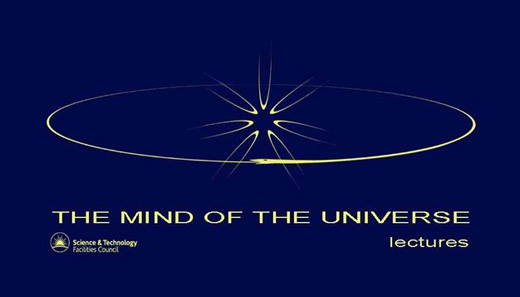
The Mind of the Universe is an ambitious project developed under a Science in Society Fellowship from the UK Science and Technology Facilities Council granted to Dr Francisco Diego. It consists of public/school lectures and teacher workshops/resources embracing topics like Origin and development of the Universe, the mystery behind the nature of the dark universe, the formation of stars and planets, space exploration and the possibility of alien life.
The project has a robust team of science advisors and strong links to UK educational organisations like the Institute of Physics, the Royal Institution, the Royal Astronomical Society and the Association for Science Education.
The Mind of the Universe project is a major component of the legacy of the International Year of Astronomy 2009, which celebrated 400 years of telescope astronomy and of Darwin 2009, celebrating the 200th anniversary of Charles Darwin's birth and the 150th anniversary of the publication of the Origin of Species by Means of Natural Selection.
For more information, and to see video recordings of the lectures, please visit: http://www.ucl.ac.uk/themindoftheuniverse/
IYA2009 Updates
5 February 2010
IYA2009 and astronomy promoted effectively in Slovenia
Dr. Andreja Gomboc, IYA2009 Single Point of Contact for Slovenia, has been promoting astronomy in Slovenian parliament. She recently gave a 30-minute talk entitled "Us and the Universe". See more here: http://www.astronomy2009.org/news/updates/769/
Galileo Teacher Training Program 2010 - Call for Proposals
The IAU and UNESCO has earmarked a certain amount of funding to support beyond IYA2009 related projects and activities in developing regions. This call for proposals comes via the Galileo Teachers Training Program GTTP cornerstone and is thus targeted at providing seed funding and basic support in order to stimulate teacher training workshops in developing regions. http://www.astronomy2009.org/news/updates/768/
"Worlds of the Sky": the first live webcast from a professional telescope of an exoplanet's transit
On Saturday, February 13, 2010 the exoplanet XO-3b will transit its parent star. Although the phenomenon itself is not spectacular, as this planet orbits its star in less than four days, it will be accompanied by an extraordinary event on Earth: for the first time ever, a professional telescope will observe the transit and the light curve will be webcast live. http://www.astronomy2009.org/news/updates/767/
The Science Prize for Online Resources in Education (SPORE)
SPORE has been established to encourage innovation and excellence in education, as well as to encourage the use of high-quality on-line resources by students, teachers, and the public. In 2009, the prize recognized outstanding projects from all regions of the world that brought freely available online resources to bear on science education. http://www.astronomy2009.org/news/updates/766/
Global Astronomy Month – April 2010
Professional and amateur astronomers, educators and all astronomy enthusiasts worldwide are invited to celebrate the Universe in April 2010, during Global Astronomy Month – an international project that builds on the achievements of The International Year of Astronomy 2009, by combining a wide array of activities with the possibility of sharing experiences in real-time! http://www.astronomy2009.org/news/updates/765/
Beyond IYA2009 National logos now available
http://www.astronomy2009.org/resources/branding/beyond
Self-doubt plagues female astronomers
Nature study seeks insight into astronomers' career paths
: http://www.nature.com/naturejobs/2010/100128/full/nj7280-574a.html
IYA2009 and astronomy promoted effectively in Slovenia
5 February 2010
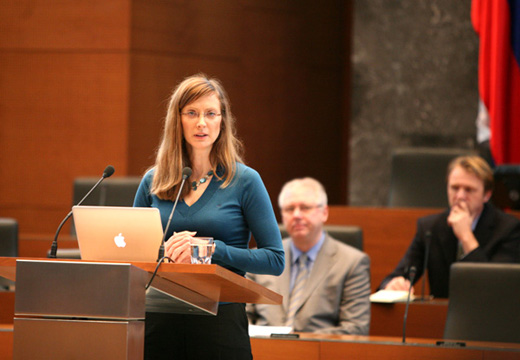
Dr. Andreja Gomboc, IYA2009 Single Point of Contact for Slovenia, has been promoting astronomy in Slovenian parliament. She recently gave a 30-minute talk entitled "Us and the Universe".
Read more about the talk here:http://www.mvzt.gov.si/nc/en/splosno/cns/news/article/94/6447/ddbb593558/
And here: http://www.dz-rs.si/index.php?id=390&no_cache=1&show_sporocilo=2589&cHash=30ce4c9756
In addition, a video recording is available to download: http://www.mvzt.gov.si/si/znanje_zanje/
Slovenia's IYA2009 Closing Ceremony was held on 14 January 2010. As part of this, a video called "Astronomy 2009: The Grand Finale" was shown. It features people working behind the scenes for IYA2009 in Slovenia. See this video (in Slovenian) here: http://www.fmf.uni-lj.si/~gomboc/MLA/Film/
Galileo Teachers Training Program 2010 - Call for Proposals
4 February 2010
The IAU and UNESCO has earmarked a certain amount of funding to support beyond IYA2009 related projects and activities in developing regions. This call for proposals comes via the Galileo Teachers Training Program GTTP cornerstone and is thus targeted at providing seed funding and basic support in order to stimulate teacher training workshops in developing regions. Note that although this funding is aimed specifically at “developing countries”, exceptions with appropriate motivation will be accepted – the main concern simply being who the beneficiaries would be. Proposals should also be in alignment with the IYA2009 goals and more specifically the GTTP goals listed in this brief and in detail in www.galileoteachers.org .
These small grants (up to 500 Euro) are intended to simply act as a stimulus to support organizations which are enthusiastic about improving the science teaching in classroom worldwide. Efficient use of these funds to train teachers capable of further train other pears and successfully implement the learned resources and tools in classroom would result in a solid start of a local community for the global GTTP effort.
The funds shall be used to:
- Produce educational material to distribution to workshop participants;
- Travel and subsistence for teachers attending the workshop, when needed.
Applications for funding are invited only via IYA2009 national nodes (each country should have an official point of contact who has been registered with the IYA2009 secretariat – full list of national nodes available on http://www.astronomy2009.org/organisation/nodes/national/ – if your country does not have a national node, please contact us for information on setting one up).
Funding Conditions
- A country is only eligible to submit proposals if it has completed the Astronomy Education Survey (see www.galileoteachers.org to check if your country has completed it).
- Funding will be limited to a maximum of 500 Euros per proposal
- Only one proposal per country will be selected.
- The proposal has to be submitted through the country SPoC (single point of contact)
- Only completed application forms will be considered
- Successful applicants will be required to sign a Terms of Reference and abide by the grant’s reporting criteria
Selection Criteria
The following criteria will be considered in the selection of projects.
- Alignment with the goals of IYA2009 and GTTP.
- Quality and relevance of workshop content.
- Innovativeness and creativity of approach.
- Clear timeline indicators.
- Cost effectiveness of the project including a detailed budget.
- Potential to raise funding from other sources
- Degree of impact of the project with potential for sustainability.
Proposal Evaluation
The proposals will be reviewed and evaluated by the GTTP Task Group in consultation with the IAU IYA2009 EC WG.
Proposal Requirements
All proposals must be submitted in completed application forms using the following link: http://www.site.galileoteachers.org/index.php?option=com_content&view=article&id=148&Itemid=50
Or alternatively sent to:
GTTP
Largo dos Topázios, 48 – 3 F
2785-817 São Domingos de Rana
Portugal
It is the responsibility of the applicant to ensure that the proposal has been received in order. All proposals received will be acknowledged by email.
Closing Date
The deadline for submitting proposals is close of business on February 25th 2010
All applicants will receive feedback regarding the decision during March 2010
The Galileo Teacher Training Program has decided to extend the deadline of the call for proposals to 25 March 2010.
Enquiries
Rosa Doran (Chair of GTTP)
Office Telephone: +351 239 854 358
Mobile Phone : +351 966 781 264
Email : info@galileoteachers.org
Website: www.galileoteachers.org
"Worlds of the Sky": the first live webcast from a professional telescope of an exoplanet's transit
3 February 2010
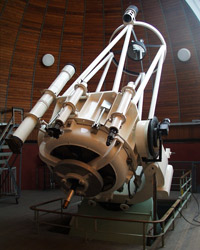
On Saturday, February 13, 2010 the exoplanet XO-3b will transit its parent star. Although the phenomenon itself is not spectacular, as this planet orbits its star in less than four days, it will be accompanied by an extraordinary event on Earth: for the first time ever, a professional telescope will observe the transit and the light curve will be webcast live.
The project is called "Worlds of the Sky", quoting the title of a famous book by Camille Flammarion, and is organised by the Brera and Palermo Observatories of the Italian National Institute of Astrophysics, in cooperation with several associations of amateur astronomers.
The unprecedented event will be broadcast live on the website www.crabnebula.it on February 13, from 7 p.m. on. The webcast will allow users around the world to watch the evolution of the light curve of the star XO-3 as the planet passes in front of it, monitored by the 1.34-metre Ruths Telescope of the Brera Observatory in Merate, Italy. The real-time data will be accompanied by comments of astronomers in English, Italian and Chinese.
The organisers intend to involve as many enthusiasts, students and teachers as possible in this novel outreach project, and wish that amateurs around the globe will monitor the event with their own instrumentation, joining efforts in this planetary "guided" observation of an otherworldly event.
The transit of an exoplanet is one of the main techniques used by astronomers to detect planets orbiting stars other than our Sun, monitoring the variations of a star's brightness.
The planet "featured" in this event, XO-3b, was discovered in 2007. It is an extremely massive one, about 13 times as massive as Jupiter, and orbits very closely the star XO-3, also known as GSC 03727-01064, in the constellation Camelopardis. The transit will last about 170 minutes.
A promotional trailer of the event, in English, Italian and Chinese, can be found on YouTube: http://www.youtube.com/watch?v=wsbW5TRo9g0
For additional information (in Italian only): http://www.crabnebula.it/rc/EANweb_newsletter/EANweb_NEWSLETTER_20091210.pdf
To learn more about exoplanets:
A press-kit from the the European Southern Observatory website: http://www.eso.org/public/outreach/products/publ/brochures/pdf/exoplanet_lowres.pdf
A practical exercise from the European Hands-On Universe website here: http://www.euhou.net/index.php?option=com_content&task=view&id=214&Itemid=13
The Science Prize for Online Resources in Education (SPORE)
3 February 2010
The Science Prize for Online Resources in Education (SPORE) has been established to encourage innovation and excellence in education, as well as to encourage the use of high-quality on-line resources by students, teachers, and the public. In 2009, the prize recognized outstanding projects from all regions of the world that brought freely available online resources to bear on science education.
Science would like to repeat the success of the SPORE prize in 2010. Winning projects should reinforce one or more of the four strands of science learning recommended by the National Academies (Taking Science to School: Learning and Teaching Science in Grades K-8 [2007], National Academies Press; see also Bruce Alberts, "Redefining Science Education," Science 23 January 2009: 323, 437;http://www.sciencemag.org/cgi/content/summary/323/5913/437) and be consistent with the science education standards published by the National Academies (National Science Education Standards [1996], National Academies Press) and the AAAS (Benchmarks for Science Literacy;http://www.project2061.org/publications/bsl/online/index.php). Please refer to the winning SPORE essays published in Science in the last issue of every month throughout 2010 for additional guidance.
Winners will be selected by the editors with the assistance of a judging panel composed of outstanding teachers and researchers in the relevant fields, chaired by the Editor-in-Chief of Science. Individuals responsible for the creation of the winning resources will be invited to write an essay that describes the resource for publication in Science in 2011.
Rules of Eligibility for SPORE-2010:
- The project must focus on science education.
- The resources described must be freely available on the Internet.
- The project can be targeted to students or teachers at the precollege or college level, or it can serve the informal education needs of the general public.
- The Internet resources must be in English or include an English translation.
- Nominations are welcome from all sources. Both self- and independent-nominations are welcome.
- Nominations must be received by 31 March 2010, with the information described below.
- Nominations should be submitted by e-mail to the address SPORE2010(at)aaas(dot)org. This is a non-reply e-mail to be used solely for the purpose of submitting SPORE nominations
Nominations: Please provide the following information about the project:
- The nominator's contact information: name, affiliation, address, telephone, and email address.
- Contact information for the person(s) who would receive the award: name, affiliation, address, telephone, and email address.
- The name and URL of the main web resource.
- A description, in 500 words or less, of why this project deserves the award.
IDENTIFY THE TARGET AUDIENCE; DESCRIBE THE GOAL AND THE TYPE OF EVIDENCE THAT EXISTS, FROM RESEARCH OR ELSEWHERE, THAT DEMONSTRATES EFFECTIVENESS. - Up to 3 brief letters of support from others may be included.
- Please email nominations to the following address: SPORE2010(at)aaas(dot)org.
The prize will be awarded without regard to sex, race, nationality, geographical location of the project, or membership in AAAS. Employees of Science and AAAS and their subsidiaries, and immediate family relatives of employees, are not eligible for the prize.
More information: http://www.sciencemag.org/feature/data/prizes/spore/
Global Astronomy Month – April 2010
2 February 2010
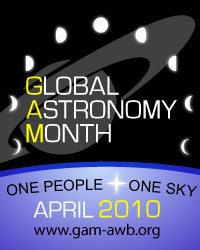
Let’s Continue the Celebration of the Universe!
Professional and amateur astronomers, educators and all astronomy enthusiasts worldwide are invited to celebrate the Universe in April 2010, during Global Astronomy Month – an international project that builds on the achievements of The International Year of Astronomy 2009, by combining a wide array of activities with the possibility of sharing experiences in real-time!
The unprecedented success of 100 Hours of Astronomy (100HA) in April 2009 showed what could be accomplished by a highly motivated and energized international community of passionate people, creating even greater enthusiasm for a follow-up experience. As challenging as it may be to follow the historic success of 100HA, Astronomers Without Borders (AWB) has set the bar even higher, inviting astronomy enthusiasts worldwide to celebrate the Universe for an entire month!
Taking place during April 2010, Global Astronomy Month (GAM2010) is a community-based effort aiming to achieve international collaboration and more interaction between participants than ever before. The primary idea of GAM2010 is to share ideas, experiences and successes, allowing communities that organize their own events to carry their ideas and inspiration forward.
“The excitement of bringing people together from all countries regardless of age, race or beliefs – all awed by the wonders of the Universe – is something that will long outlive the International Year of Astronomy 2009 (IYA2009)”, says Mike Simmons, President of AWB and co-chair of the 2009 100HA effort. “GAM2010 will build on that passion and energy, starting from a simple idea and building to a global project by multiplying its effect as it goes. Like 100 Hours of Astronomy, GAM will be a social movement in the astronomy community”
With an entire month available, GAM2010 event organizers have four advantages over 100HA in 2009: 1) the ability to plan events at the best times in their countries, 2) time to reschedule weather-impacted outdoor events, 3) more ways to engage participants and the public with a wider array of projects and activities, and 4) the opportunity to be inspired by – and be the inspiration for – fellow astronomy enthusiasts around the world.
GAM2010 includes the most popular events for both astronomers and the public: telescopes will be available for the viewing of the Moon, Saturn and other objects, not only at observatories and planetariums, but also in public locations; dark sky observing of distant objects, Messier marathon, Lyrid Meteor Shower observing parties and events for the annual celebration of Astronomy Day (April, 24) are just some of the activities planned; special events by IYA2009-created global programs, observing with telescopes controlled over the Internet, webcasts and podcasts of special presentations, exhibitions, public competitions, astrophotography contests and workshops and much more will ensure that there is something for everyone.
The GAM2010 web site is the hub of all the activity, providing up-to-date and even real time information, as well as acting as a platform for sharing ideas and results that will foster international cooperation in event planning, creating even more a sense of a global community.
The GAM2010 On-line Broadcast Channel offers organizers worldwide a place to show videos of their events, give presentations of interest to the general public and feature live streams from around the world in their own events.
The GAM2010 Blogs are a valuable source of information and event promotion. GAM bloggers will describe important projects and events, while local organizers can post information on their own activities. Social media and networks will also be used to expand the audience and the excitement.
Come and join the celebration this April, as Global Astronomy Month will bring together thousands of passionate individuals and hundreds of organizations worldwide to share their enthusiasm and innovation, and to connect people through this great sense of sharing! It’s a month celebrating of One People, One Sky!
####
More information:
- Website: www.gam-awb.org
- Blogs: http://gam-awb.org/gam-project-blog.html
- Twitter: http://twitter.com/GAM_2010
- Facebook: http://www.facebook.com/pages/Global-Astronomy-Month-2010/226861742445
Astronomers Without Borders
Astronomers Without Borders is an organization dedicated to fostering understanding and goodwill across national and cultural boundaries by creating relationships through the universal appeal of astronomy. Astronomers Without Borders projects promote sharing, all through a common interest in something basic and universal – sharing the sky.
Contact Person:
Mike Simmons
President, Astronomers Without Borders
Chair, GAM2010 Working Group
+1 818 486 7633
Oana Sandu
GAM2010 Public Relations Coordinator
+40 724 024 625
Search IYA2009 Updates

National Nodes: 148
Organisational Nodes: 40
Organisational Associates:33
National Websites: 111
Cornerstone Projects: 12
Special Task Groups: 11
Special Projects:16
Official Products:8
Media Partners:22


